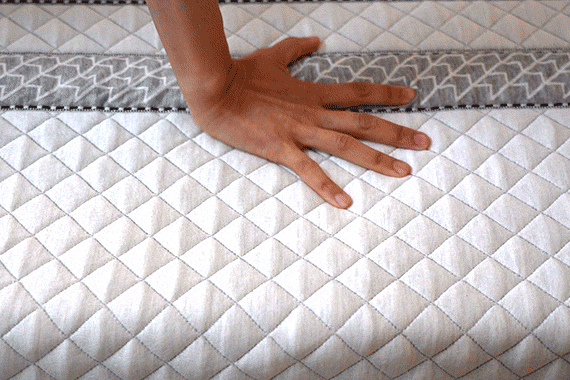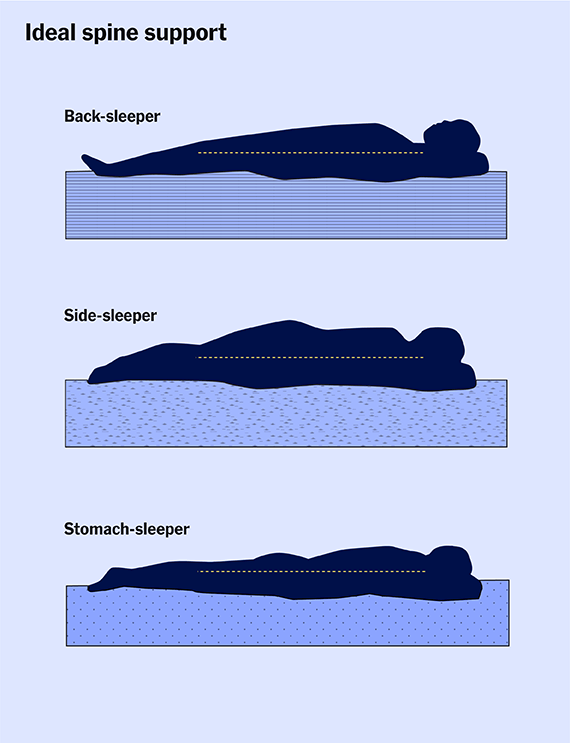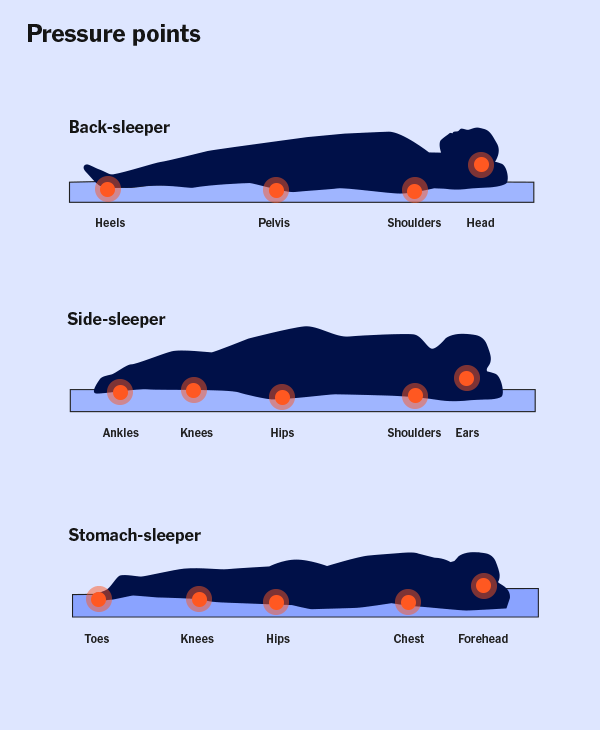
Welcome to the ULTIMATE mattress buyers guide for 2025.
When it comes to mattress shopping, many people make the mistake of only considering a few arbitrary factors.
Things such as firmness level or sleep position, or basing their decision solely on price or materials and technology featured in advertisements.
However, this approach can often lead to purchasing a mattress that is not comfortable and may ultimately result in regret.
To avoid this situation and find a mattress that you will be happy with for years to come, it is important to take a more comprehensive approach.
This means considering not only firmness and sleep position, but also focusing on comfort and support.
Also, it can be helpful to do your research and read customer reviews to get a sense of which mattresses may be the best fit for you.
In this guide, we will provide advice and recommendations based on our extensive research and sleep testing.
By following this advice, you will be able to find a mattress that offers the comfort and support you need for a good night’s sleep.
When it comes to choosing a mattress, there are several options to consider.
Foam mattresses, which can be made of memory foam, polyfoam, latex foam, or a combination, are a popular choice.
Innerspring mattresses, which use coil springs to provide support, are another option.
And hybrid mattresses, which combine foam and springs, are a third option.
While there are many mattresses to choose from, we recommend:
- Nectar mattress – Memory foam
- Zenhaven – Latex foam
- Saatva Classic – Innerspring
- Leesa Hybrid – Foam and coil
- Sweetnight Dreamy – Hybrid
These were chosen for their comfort, price, and generous trial periods.
However, these are just starting points, as comfort is highly subjective and no single mattress will work for everyone.
If you’re not sure which type of mattress is right for you, there are some tips you can follow to figure out which type you might like best.
For example, you can consider your body type, your preferred sleeping position, and your budget.
Additionally, our guides to the best foam, innerspring, latex and hybrid mattresses can provide more recommendations to help you make an informed decision.
When Should You Buy A New Mattress?

If you’re not feeling rested and comfortable after a night’s sleep, it may be time to consider a new mattress.
A lack of proper support and cushioning can lead to aches and pains, especially in the shoulders, back, hips, knees, and other joints.
If your current mattress is saggy or has indentations that match your body shape, it’s probably not providing the support you need.
If you find that you sleep better in other places, such as hotels or vacation rentals, that’s another sign that your mattress may be past its prime.
Before investing in a new mattress, it’s important to make sure that other factors aren’t contributing to your discomfort.
If you’re experiencing neck pain, your pillow may be to blame, and it may be worth consulting our guide to the best bed pillows.
And if your new mattress feels too firm, you may be able to improve its comfort with a good mattress topper.
There are many options to choose from when it comes to mattress toppers, including memory foam, latex, and feather and down.
We recommend the PlushBeds Natural Latex Mattress Topper for their comfort and support.
However, keep in mind that comfort is highly subjective and what works for one person may not work for another.
Our guide to the best mattress toppers can provide more recommendations to help you find the right option for you.
Mattress Types

There are many types of mattresses on the market, but most can be grouped into four categories: innerspring, foam, hybrid and latex.
In this article, we will provide a brief overview of each type.
Innerspring Mattresses
Innerspring mattresses, also known as spring mattresses, are the most traditional type of mattress.
They are made with a core of interconnected steel coils that provide support and bounce.
The coils are usually surrounded by layers of padding, such as foam or cotton, for added comfort.
Innerspring mattresses are known for their durability and long-lasting support, and are a popular choice for people who prefer a firmer sleep surface.
However, some people may find them to be too firm or to lack sufficient contouring, leading to discomfort and pressure points.
Foam Mattresses
Foam mattresses are made with layers of dense foam that contour to the shape of your body for a comfortable and supportive sleep surface.
The foam used in these mattresses is usually high-density polyurethane, which is known for its durability and ability to retain its shape over time.
Foam mattresses are typically more responsive than innerspring mattresses, meaning that they adjust more quickly to your body’s movements during the night.
This can help to reduce pressure points and promote a more restful sleep.
Foam mattresses are also often available in a wider range of firmness levels, allowing you to choose the level of support and comfort that best suits your needs.
However, some people may find foam mattresses to be too soft, leading to a lack of support and potential sagging over time.
Hybrid Mattresses
Hybrid mattresses are a combination of innerspring and foam mattresses.
They have a core of interconnected steel coils for support, surrounded by layers of foam for added comfort and contouring.
The foam used in these mattresses is often more responsive than the foam used in traditional innerspring mattresses, which can help to reduce pressure points and promote a more restful sleep.
Hybrid mattresses are known for their durability and long-lasting support, and are a popular choice for people who want the support of an innerspring mattress with the added comfort and contouring of foam.
However, they can be more expensive than traditional innerspring or foam mattresses, and some people may find them to be too firm or too soft, depending on the individual’s preferences.
Latex Mattresses
Latex mattresses are made with layers of natural or synthetic latex foam.
Natural latex is derived from the sap of rubber trees, while synthetic latex is made through a chemical process.
Latex mattresses are known for their durability and ability to retain their shape over time.
They are also often more responsive than foam mattresses, meaning that they adjust more quickly to your body’s movements during the night.
This can help to reduce pressure points and promote a more restful sleep.
Latex mattresses are typically available in a range of firmness levels, allowing you to choose the level of support and comfort that best suits your needs.
However, latex mattresses can be more expensive than other types of mattresses, and some people may find them to be too firm or too soft, depending on their individual preferences.
How To Choose A Mattress

When it comes to choosing a mattress, there are a few key factors to consider.
First, think about your personal preferences and needs.
Do you prefer a firmer or softer sleep surface?
Do you have any specific health or medical conditions that may affect your choice of mattress?
Once you have a good idea of what you’re looking for, it’s time to start shopping.
One of the most important things to consider when choosing a mattress is the type of mattress.
As previously mentioned, there are four main types: innerspring, foam, hybrid and latex.
Each type has its own unique benefits and drawbacks, so it’s important to consider which one will best meet your needs.
Another important factor to consider is the firmness level of the mattress.
Most mattresses are available in a range of firmness levels, from very soft to very firm.
The right firmness level for you will depend on your personal preferences and your body type.
For example, if you have a larger body, you may prefer a firmer mattress to provide adequate support.
On the other hand, if you have a smaller body, you may prefer a softer mattress to provide more contouring and pressure relief.
Once you’ve narrowed down your choices to a few potential mattresses, it’s time to try them out.
Most mattress stores and online retailers offer a trial period during which you can sleep on the mattress to see if it’s a good fit for you.
Be sure to take advantage of this opportunity to ensure that you’re happy with your purchase.
It may take a significant amount of time sleeping on a mattress to determine if it is comfortable for long-term use.
It is not uncommon for it to take a month or more to make this assessment.
It is important to take the time to properly test a mattress before making a decision.
Finally, consider the price of the mattress.
Mattresses can range in price from a couple hundred dollars on up to several thousand dollars.
It’s important to find a balance between your budget and your needs.
Remember, a good mattress is an investment in your health and well-being, so it’s worth spending a little extra to get one that will provide the support and comfort you need.
Questions To Ask When Shopping For A Mattress

When shopping for a new mattress, you can begin by asking yourself a few questions.
If you can answer “yes” to all of them, it’s likely that the mattress you’ve chosen is comfortable.
This can help you make an informed decision and find a bed that will help you get a good night’s sleep.
Is It Too Firm Or Soft?
When shopping for a new mattress, it’s important to keep an open mind and try out a range of firmness levels.
The only way to really understand what a mattress’s “firm” or “soft” description means is to lie down on it.
There are no standardizations for these terms across different brands, so the “firm” mattress from one brand may not feel the same as the “firm” mattress from another brand.
In our own tests, we have found that people who thought they wanted a firm mattress often ended up preferring a medium-firm mattress.
When reading online reviews, keep in mind that firmness is a subjective concept and what one person considers to be “too firm” may be “just right” for someone else.
If you’re shopping in a store, try out the firmest version of the mattress you’re interested in, and then try progressively softer versions until you find the right firmness for you.
Does It Cradle Or Cushion You Like You Prefer?
When deciding on a new mattress, consider whether you prefer a conforming or a supportive feel.
Memory foam and foam-forward hybrids will typically conform to your body, while innerspring mattresses will offer more support.
Innerspring mattresses can also be quite plush, thanks to a pillow top or Euro top, and allow for more freedom of movement.
Latex mattresses, which are made from the sap of rubber trees, offer a combination of conforming and supportive qualities.
Ultimately, the best mattress for you will depend on your personal preferences and sleeping style.
Do You Prefer Bounce And Does It Have Enough?
Innerspring mattresses and hybrids with a significant number of innerspring coils can provide a bouncy feel that many people are familiar with from their childhoods.
However, memory foam with latex layers or an all-latex mattress can also offer a springy feel that some people prefer.
Both innersprings and latex can provide comfort for people who move around a lot in bed, whether they’re alone or with a partner.
Does It Keep You Cool Or Warm Enough?
If you tend to sleep hot, you may want to avoid foam mattresses, which can trap heat.
Innerspring mattresses are generally more breathable because they allow body heat to move through the spaces in the coils and disperse into the room.
If you like the feel of foam but need a mattress that sleeps cool, consider a hybrid with a combination of foam and innersprings, or an innerspring mattress with a foam topper.
Some foam mattresses are made with materials that are designed to promote the transfer of heat, like foam with air channels or copper, gel, or graphite infusions, but these can be expensive and may not work for everyone.
Latex mattresses are another option for hot sleepers because they sleep cooler and offer a springier feel than memory foam.
Does It Have Enough Edge Support For You?

If you like to sit on the edge of your bed, you’ll want a mattress with dedicated edge support.
A common way to provide edge support for innerspring mattresses is to use high-density foam encasements or stiffer coils around the perimeter of the mattress.
This helps prevent the edges from sagging or collapsing when someone sits or sleeps near the edge of the mattress.
While the foam encasement may provide a comfortable feel, it can soften over time. If you spend a lot of time sitting on the side of your bed, you may want to consider a mattress with stiffer edge coils for added durability.
The edge support in foam-forward hybrids and foam mattresses depends on the density of the foam in the support layers, so it’s important to try out the mattress before making a decision.
Some examples of mattresses with strong edge support include the Dreamcloud and the Helix Midnight.
Is It Good For Both You And Your Partner?
When sleeping with a partner, it can be challenging to find a mattress that meets both people’s preferences.
If one partner has musculoskeletal issues, such as lower back pain, it’s best to prioritize their comfort.
If neither partner has any specific concerns, you could choose a firmer mattress and add a twin-size topper to one side for a softer feel.
If you can’t find a mattress that works for both of you, adjustable air beds, such as those from Sleep Number, can be a good solution because they allow each person to adjust the firmness to their liking.
Some bedding stores also offer this option for foam and innerspring mattresses.
If you’re sensitive to movement, a good option for you may be a mattress with good motion isolation.
This means that the mattress does a good job of absorbing and limiting the transfer of movement, so that you’re less likely to be disturbed by your partner’s movements during the night.
Foam mattresses are generally good at limiting the sensation of movement, but you can also find this quality in hybrid and innerspring mattresses, particularly those with pocket coils, which are individually wrapped in fabric rather than wired together as a unit.
Does It Look And Feel High Quality?
When shopping for a mattress, it’s important to consider its quality and durability.
One way to assess a mattress’s potential longevity is to physically inspect it and check its cover for sturdiness and proper stitching.
Another factor to consider, especially for foam or hybrid mattresses, is the density of the foam used in the top layers.
As a general rule, memory foam mattresses with a density of at least 3 pounds per cubic foot are suitable for adults who weigh less than 200 pounds, while those who weigh more should look for a density of at least 4 pounds per cubic foot.

When shopping for a non-memory foam polyfoam mattress, it is important to consider the density of the foam.
If you weigh less than 200 pounds, a foam density of 1.8 pounds per cubic foot or higher is recommended.
For those who weigh more than 200 pounds, a density of 2 pounds per cubic foot or higher is recommended.
It is also important to consider the transparency of the brand in regards to materials and foam density specifications.
If this information is not readily available on the brand’s website, it may be helpful to reach out to a customer service representative or visit a store to learn more.
Prioritizing durability can be achieved by choosing a brand that is transparent about their materials.
When choosing an innerspring mattress, it is important to consider the type and gauge of the springs.
Pocket coils are known for providing excellent motion isolation and comfort that conforms to your body.
Support coils, which are typically found in the lower layers of a mattress, are more durable when they are between 12 and 15 gauge.
In general, the lower the gauge, the firmer the feel of the mattress will be. It is also important to consider the number of support coils in the mattress.
A mattress with more support coils is typically more durable than one with fewer coils of similar quality.
Less expensive innerspring mattresses may offer a firmer feel by placing the coils closer together, rather than using thicker coils.
Are There Risks For Body Impressions?
All types of mattresses can develop body impressions over time.
This is especially true for foam and hybrid mattresses with cheaper, less dense foam and for those who weigh more.
Innerspring mattresses with thicker pillow or Euro tops are also more prone to body impressions.
While it is difficult to avoid body indentations completely, you can minimize their effect by rotating the mattress at least every six months and sleeping in different positions.
Quilting on the top of the mattress can help make indentations less noticeable, and the steel coils in innerspring mattresses provide additional support to prevent sagging.
Mattress manufacturers have noted that it is difficult to quilt through dense polyfoams, which are typically in the range of 1.7 pounds per cubic foot.
All-latex mattresses and innersprings topped with latex are generally more resistant to sagging and body impressions than memory foam mattresses.
This is true for people of all weights. While the quality of the components used in a mattress is important, it is also crucial to consider how they are put together.
Choosing a mattress made with high-quality components and construction can help reduce the risk of disappointment over time.
What Is The Return Policy?
Many online mattress companies offer a free trial period of around 100 days when you purchase directly from the company.
Some may require you to try the mattress for 30 days before initiating a return.
The return policies of third-party retailers, such as Amazon, department stores, and mattress stores, may vary depending on where the mattress was purchased.
It is important to check the return policy before making a purchase.
Are You Really Getting A Deal?
When shopping for a mattress, it is important to consider the suggested retail price (SRP) provided by the manufacturer.
This is especially relevant when purchasing from a third-party retailer, as the final sale price is determined by the retailer.
Retailers may mark up the price above the SRP and then offer a discount, making it appear as though they are offering a good deal.
To determine whether a retailer is offering a good price, it is helpful to check the SRP on the manufacturer’s or brand’s website before making a purchase.
Consider Your Sleep Position
If you are experiencing aches and pains while sleeping, it may be because your body is not properly supported.
Neck and shoulder pain may be caused by inadequate pillows, while back pain or other types of discomfort may be a sign that you need a more supportive mattress.
To achieve the best level of support, it is important to find a balance between spinal support, which requires some degree of mattress firmness, and pressure-point relief, which requires some degree of softness.
This balance will vary depending on your preferred sleep position.
Proper spinal alignment is important for maintaining good health and preventing pain.

When lying down, your spine should be relatively straight, with a subtle curve inward towards the belly in the lower back.
Pressure points are areas of the body that press against the surface of the mattress, such as the shoulders, hips, or knees.
These vary depending on your sleep position. Pressure-point relief can be beneficial for those with muscle or joint issues.
For example, if you’re a side-sleeper with hip pain or rotator cuff tendinitis, it’s important to choose a mattress that’s not too firm.
A mattress that’s too firm can put excessive pressure on these areas, causing discomfort and exacerbating your pain.
A mattress with the right level of firmness can help alleviate pressure on these sensitive areas and provide more comfortable support.
In the case of injuries or chronic pain, it may be best to avoid sleeping on your side until the issue has healed.

For most people, pressure points are not a major concern during sleep.
This is because most people move around a lot while they sleep.
However, if you are trying out a mattress and feel it pushing against certain parts of your body, it is probably not the right mattress for you in terms of comfort.
If the sensation is bothersome in the showroom, it is likely to be even more of a nuisance when you are trying to fall asleep at night.
Some mattress manufacturers offer “zoned” layers that are firmer in areas that require extra support, such as the lower back.
However, the effectiveness of this feature may vary depending on your body type and sleep position.
To determine whether a zoned mattress is right for you, it is important to try it out and see if you can feel the difference between the various zones.
Even if you can, the improvement in sleep quality may be minimal depending on your height, weight, and weight distribution, as well as your preferred sleep position.
In general, the following features should be considered based on your sleep position, as well as tips on how to check for proper alignment:
Back Sleepers
If you prefer to sleep on your back, a medium-firm mattress is generally recommended.
This type of mattress should provide enough support to maintain proper spinal alignment while also being soft enough to keep your lower back, hips, and shoulders comfortable.
To check for proper alignment, you can ask someone to take a picture of you lying on the mattress. Your spine should form a straight line from your neck to your lumbar region to your knees.
According to Vincent Verhaert, a doctor of mechanical engineering and biomechanics who is also the owner of Belgian mattress company Equilli, a good way to test the support of your mattress is to try sliding your hand under your lower back while lying on it.
If it is a snug fit, the mattress provides good support. If the space is too tight, the mattress may be too soft, while a too-slack space indicates that the mattress is too firm.
If you’re experiencing back and neck pain while sleeping, it’s worth considering whether your pillow might be the cause.
For back sleepers, a pillow with less loft may be necessary to maintain proper alignment.
An adjustable shredded-foam pillow, such as the Nest Bedding Easy Breather Pillow, allows you to remove as much filling as needed to achieve a perfect fit.
Additionally, a neck roll can provide additional support by filling in the gap between your neck and the mattress.
The Ecosa contoured neck roll, which combines the benefits of a pillow and neck roll in one, is a great option and is featured in our guide to the best memory-foam pillows.
Side Sleepers
If you tend to sleep on your side, you need a mattress that offers good pressure relief for your hips and shoulders.
For most side sleepers, a mattress that feels medium-soft to medium will work well.
Some slightly firmer mattresses may also be suitable for side sleepers who require more support or don’t like the “huggy” sensation of memory foam.
To test for good alignment, have someone take a picture of you from behind.
If you can draw a relatively straight line connecting the midpoint of your ears, shoulders, and hips, your mattress is likely providing good alignment.
If your hips or shoulders feel like they’re bottoming out, a firmer mattress may be necessary. For added cushioning, a medium-firm to firm mattress with a mattress topper can provide a more customized sleeping experience.
Side sleepers generally need more support from their pillow than those who sleep on their back or stomach.
To provide better cushioning for your shoulder, try sleeping higher on your current pillow, making sure to maintain proper spinal alignment.
When it comes to finding a new pillow, our side-sleeping testers have consistently recommended the Nest Bedding Easy Breather Pillow.
This pillow has proven to be a favorite among side-sleepers for its comfortable support and breathability.
It’s a great option if you’re in the market for a new pillow.
Stomach Sleepers
If you tend to sleep on your stomach, a firmer mattress on the medium-firm side will likely provide the best support and cushioning for your chest, hips, knees and belly, while maintaining proper spinal alignment.
The sink of an all-foam mattress may put too much strain on your lower back, but you also don’t want to feel like your ribs or other parts of your body are pressing too hard against the mattress.
A medium-firm mattress with slightly more cushioning may be a better option. To test for proper alignment, have someone take a picture of you from the side.
If you can draw a straight line from your neck to your lower back to your knees, your mattress is likely providing good alignment.
If the curvature of your lower back looks exaggerated or you feel the force of gravity pulling on your belly, a more supportive mattress may be necessary.
Stomach sleepers often have a hard time finding a pillow with the right loft, so if you’re having trouble sleeping, your pillow may be the culprit.
In our testing, we’ve found that stomach sleepers often prefer down and down-alternative pillows, such as the Sleep Number PlushComfort Pillow Ultimate.
The Sleep Number has adjustable fills that make it easy for stomach sleepers to find the right fit for their body shape.
How To Choose The Right Mattress Size
If you’re unsure which mattress size to get, it’s generally a good idea to go with the larger option if it fits within your budget and space constraints.
A queen or king size mattress may not be necessary when you have the whole bed to yourself, but most people find that it’s worth the upgrade if it allows them to feel more comfortable while sleeping.
If you sleep with someone else, a larger bed can significantly improve the quality of your sleep.
With more room, you’ll be less likely to be disturbed by the other person’s movements, and you’ll have more space to stretch out, which can help alleviate muscle and joint pain.
This is particularly important if you have kids or pets who like to join you in bed.

In contrast, if they choose a full-size mattress, each person will have as much room as they would in a crib, according to The Better Sleep Council. (The Better Sleep Council is the consumer arm of bedding companies and therefore may have a bias, but in this case, their advice is worth considering.)
| Mattress | Size in inches |
| Crib | 27 by 52 |
| Twin | 38 by 75 |
| Twin XL | 38 by 80 |
| Full | 53 by 75 |
| Full XL | 53 by 80 |
| Queen | 60 by 80 |
| King | 76 by 80 |
| California king | 72 by 84 |
Keep in mind that buying a different-size bed from what you currently have will incur additional costs beyond the price of the mattress itself.
You’re going to need new sheets and a bed frame that fits the new mattress, as well as a waterproof mattress pad and mattress encasement to protect your investment.
You may also want to purchase new bedding, such as a comforter and duvet cover, as well as larger, more expensive pillows.
While you don’t need to buy all of these items at once, it’s important to consider the total cost of upgrading your mattress so that you can make an informed decision.
Off-Gassing and Flame Retardants
New mattresses, particularly foam mattresses that have been wrapped in plastic, can have an unpleasant odor.
This is due to the mattress off-gassing, or releasing volatile organic compounds (VOCs).
To avoid the worst offenders, look for mattresses with foam that is CertiPUR-US certified.
CertiPUR-US certification ensures that the foam is free of certain chemicals, including PBDEs, TDCPP, and TCEP flame retardants.
It’s unlikely that your mattress is made with flame retardants.
Most mattress manufacturers (with the exception of those designing mattresses for hospitals or correctional facilities) can meet federal flammability standards using a sock cover with flame-retardant properties or ticking, according to Michael Crowell, the executive director of CertiPUR-US.
Some all-foam mattresses, particularly cheaper ones, may contain fiberglass as a fire barrier to comply with flammability standards.
If you’ve purchased a boxed mattress, it’s a good idea to let it air out for a few days in a well-ventilated area before sleeping on it.
Ideally, this would be in a rarely used room, but if that’s not possible, make sure to keep your windows open and fans running as much as possible.
If you’re sensitive to smells, pregnant, or have asthma, avoid the room until the scent has completely dissipated.
If you’re concerned about VOCs, you may want to opt for a mattress that is delivered conventionally (flat and brought in by delivery people) instead of one that comes in a box.
Foam and hybrid mattresses of this type have typically undergone off-gassing in the factory before arriving in your home, so they are less likely to have an odor.
Innerspring and latex mattresses are even less likely to have an off-gassing problem.
How Much Should You Spend On A Mattress?

President’s Day is a popular time for mattress sales, but in reality, there are always sales going on.
Don’t believe a salesperson if they try to convince you that a blowout deal will disappear the moment you leave the store.
If they’re using scare tactics like that, it’s a good idea to walk out. When you do start shopping, here is a rough estimate of what you can expect to pay for a queen-size mattress in different price ranges:
Under $500: If you want an innerspring mattress, you’re unlikely to find a good quality one for less than $500. Around this price range, your options are generally limited to foam-forward or all foam hybrid mattresses. The cheaper the mattress, the more likely it is to be made with lower-quality polyfoam and memory foam, and have fewer layers of it. Inexpensive mattresses also tend to be firmer and less durable than pricier options. However, those on a tight budget do have a few comfortable options to choose from, including the Sweetnight Dreamy Hybrid, which is our pick for the best mattress under $500.
Under $1,000: In the $500 to $1,000 price range, you can find decent foam and innerspring mattresses, such as the Nectar mattress, a pick in our foam mattress guide, or the IKEA Hesstun, the cheapest innerspring mattress we recommend. However, you won’t find many additional features at this price range. At the higher end of this spectrum, you may find denser foams, more padding, heat-transfer materials such as gels, and stronger gauges and higher coil counts in some cases. If you’re capable of spending around $1,000, you’ll most likely find better-cushioned innersprings, such as the Serta Perfect Sleeper Select Kleinmon II, as well as some entry-level hybrids, such as the Allswell Luxe Hybrid, which is a notable contender in our foam mattress guide.
$1,000 to $3,000: In the $1,000 to $1,500 price range, you’ll find a wide selection of high-quality spring, foam, and hybrid mattresses with denser foam and more layers. This means that the mattress, especially one that costs around $1,500 or more, like our foam picks, the Loom & Leaf and the Tempur-Adapt, can likely support heavier individuals and maintain its shape for longer than cheaper mattresses. You’ll also likely notice more motion isolation and solid edge support in this category of innerspring mattresses, such as the WinkBed and the Saatva Classic, both of which are included in our innerspring mattress guide. However, this is not always the case. As the price increases, you’ll find covers and upholstery with a greater proportion of natural fibers, such as cotton and wool, compared to what you’ll find in cheaper mattresses. You’ll also find what’s known as “exotic” foams, which includes Talalay latex and gel foams.
$3,000 and up: At the luxury end of the mattress market, the sky is the limit. You can expect thicker layers and even denser foams in these mattresses. In general, these mattresses can support heavier weights and withstand more wear and tear. In hybrid and innerspring models, you’ll find impressively high coil counts, hand tufting, and overall finer materials, such as Joma Wool and even horsehair. These are nice-to-have extras, but beyond a certain price point, you may not necessarily get a significantly more comfortable night’s sleep than you would on a mattress that costs a thousand dollars less. Many of the experts we spoke with said that beyond $5,000, mattresses don’t necessarily become more comfortable; what you do get is more luxury (Egyptian or organic cotton instead of regular cotton, for example), better tailoring, and nicer aesthetics.
